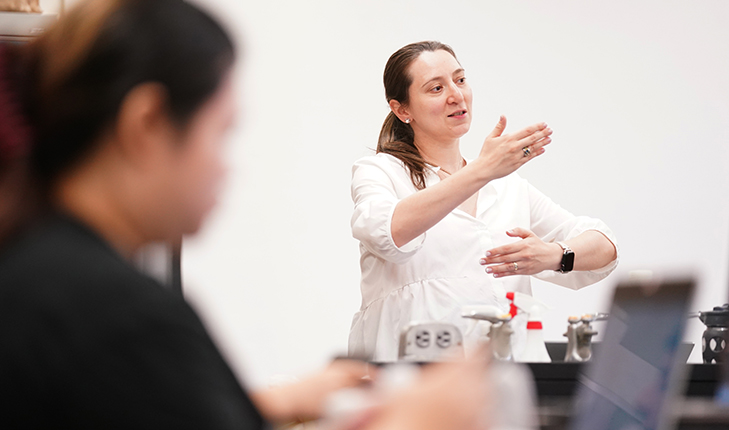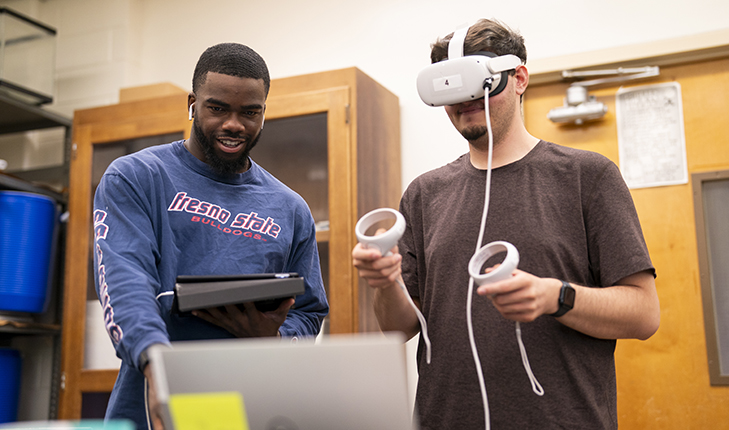Skip to content
Biology professor uses VR to help students visualize the human brain
Fresno State senior Dustin Geringer put on a virtual reality (VR) headset for the first time this year to get a three-dimensional and immersive educational experience learning about the nervous system and human brain.
It’s a bit disorienting at first, and when the goggles come off, but after a while, the technology becomes an extension of the arm, said the biology major from San Jose.
“It’s a useful tool for learning for all ages,” said Geringer, after he used the motion controllers to remove layers of nerves, blood vessels and more on 3D scans of the human brain so he could record and study the images in his physiology lab this semester.
Since spring 2023, Fresno State biology professor Dr. Anahit Hovhannisyan has integrated VR technology into some of her classes to help students with visualization and memorization of the human brain anatomy.
Hovhannisyan, a neuroscientist who has taught at Fresno State for six years, is technology and innovation driven. She was already looking for a program in her neuroanatomy class to allow students to learn the human brain anatomy and explore real human brain case studies when she saw a syGlass VR demonstration at a Society for Neuroscience conference. The program looked appealing and suitable for her class, she said.
“Memorizing structures and learning their locations in anatomy classes is mostly related to memorization and not much of logical implementation. I was looking for ways of how I can make my students get the logical component and learn anatomical structures easier,” Hovhannisyan said. “How can I improve the memorization process?”
She was part of a program in the Lyles College of Engineering at Fresno State that trained faculty to implement VR in their courses. VR headsets and resources, along with high-powered laptops capable of running the image-heavy software program, were provided through the program and the Fresno State Library with support from the Provost’s Office. Hovhannisyan also secured some funding from the College of Science and Mathematics’ dean’s office for the syGlass program and VR in her neuroanatomy lab class in spring 2023 and 2024, and her physiology lab this fall.

Then, it was implementation time. There is a steep learning curve, Hovhannissyan said. Students have to learn how to use the VR and then navigate the custom-designed syGlass application with different data sets. Once they got familiar with all of it, they did well using the program, she said.
In a recent physiology lab, students broke up into small groups of two to three people and took turns exploring the program and collecting data. One student at a time put on the Oculus headset and grabbed the controllers to begin their visualization of the human brain moving their hands and heads up and down, left to right. The others in the groups watched the interaction on the laptop screen.
Student surveys of VR use in class were positive, Hovhannisyan said, though some complained about not having enough time and wished the class was longer. She takes that as a positive sign.
“That’s really good. That means that they were learning,” she said “They weren’t just coming and making pictures. They wanted to learn and this indicated that implementing this component made them want to learn.”
Technology, especially robotics and artificial intelligence, is a 21st-century intervention that is becoming part of life, Hovhanissyan said. People were resistant to the calculator way back when, but everyone uses them now, she said.
“We use it as a tool and the same can be said with technological improvements and artificial intelligence tools,” Hovhannisyan said. “All of those things need to be part of educating so students can use them as tools to improve their learning process and help them to learn easier.”
Share This Story, Choose Your Platform!





